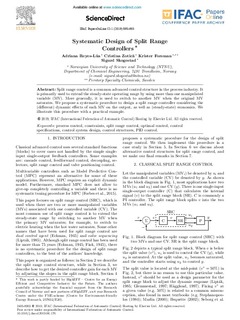| dc.contributor.author | Reyes-Lúa, Adriana | |
| dc.contributor.author | Zotica, Cristina Florina | |
| dc.contributor.author | Forsman, Leif Krister | |
| dc.contributor.author | Skogestad, Sigurd | |
| dc.date.accessioned | 2019-09-02T14:09:08Z | |
| dc.date.available | 2019-09-02T14:09:08Z | |
| dc.date.created | 2019-05-14T13:42:29Z | |
| dc.date.issued | 2019 | |
| dc.identifier.issn | 2405-8963 | |
| dc.identifier.uri | http://hdl.handle.net/11250/2612097 | |
| dc.description.abstract | Split range control is a common advanced control structure in the process industry. It is primarily used to extend the steady-state operating range by using more than one manipulated variable (MV). More generally, it is used to switch to another MV when the original MV saturates. We propose a systematic procedure to design a split range controller considering the (different) dynamic effects of each MV on the output, as well as (steady-state) economics. We illustrate this procedure with a practical example. | |
| dc.description.abstract | Systematic Design of Split Range Controllers | |
| dc.language.iso | eng | |
| dc.publisher | International Federation of Automatic Control (IFAC) | |
| dc.rights | Attribution-NonCommercial-NoDerivatives 4.0 Internasjonal | |
| dc.rights.uri | http://creativecommons.org/licenses/by-nc-nd/4.0/deed.no | |
| dc.title | Systematic Design of Split Range Controllers | |
| dc.type | Peer reviewed | |
| dc.type | Journal article | |
| dc.description.version | publishedVersion | |
| dc.source.journal | IFAC-PapersOnLine | |
| dc.identifier.cristin | 1697799 | |
| dc.relation.project | Norges forskningsråd: 257632 | |
| dc.description.localcode | © 2019, IFAC (International Federation of Automatic Control) Hosting by Elsevier Ltd. | |
| cristin.unitcode | 194,66,30,0 | |
| cristin.unitname | Institutt for kjemisk prosessteknologi | |
| cristin.ispublished | true | |
| cristin.fulltext | postprint | |
| cristin.qualitycode | 1 | |

